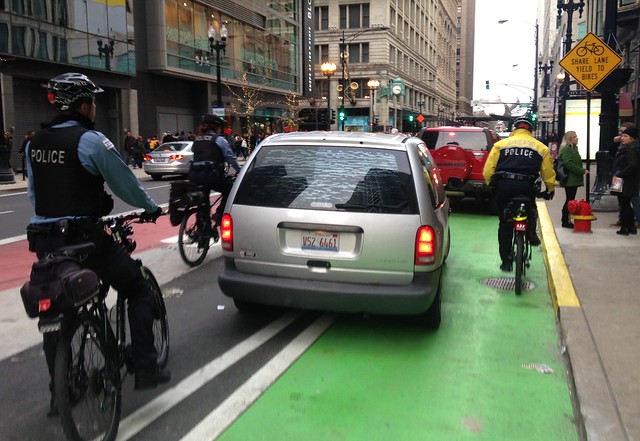Like kids unwrapping presents, travelers in downtown Chicago had some shiny new infrastructure to try out Sunday morning. The Loop Link bus rapid transit system debuted on a day when weekday traffic wasn't an issue, although the central business district was packed with holiday shoppers. Monday will be the first big test of the system.
The main part of the bus corridor runs about a mile across the Loop district on Washington and Madison streets, where giant bus shelters with near-level boarding platforms have been constructed. On Washington, a new protected bike lane runs between the sidewalk and the island stations.
The route also includes Canal and Clinton streets in the West Loop, so it connects the two West Loop commuter rail stations with Michigan Avenue. Six different bus routes that terminate in different corners of the city are now using the corridor, which is designed to double bus speeds from the previous sluggish pace of 3 mph during rush hours.
Time-saving features include red concrete bus-only lanes, limited stops, and white "queue jump" signals at intersections, which give buses a head start, similar to "leading pedestrian interval" traffic signal timing. The queue jumps are currently in effect and seem to function well. Pre-paid boarding isn't in effect yet, but the city says it will be tested this spring at the station on Madison at Dearborn Street. Read this post for more info about the design of the Loop Link corridor.

The system is still very much a work in progress. Only seven of the eight planned stations are built -- one at Washington and Wabash Avenue will be constructed after work on a new elevated station nearby is finished. Some of the existing shelters are still under construction. And bus drivers, motorists, bike riders, and pedestrians will need some time to get used to the new traffic patterns.
That said, things seemed to be functioning pretty well on Sunday. True, cars in the remaining two mixed-traffic lanes on Washington were moving pretty slowly when I visited in the late afternoon, but it was prime shopping time. In particular, lots of people were walking between the State Street retail strip to the German Christmas market at Daley Plaza, which made it difficult for drivers to turn north onto Dearborn.
But CTA riders seemed to appreciate how easy it is to board the buses now, similar to walking aboard an 'L' car, as well as the plentiful seating in the shelters. Annoyingly, the glass panels of the structures stop several feet below the roof, which means they'll provide minimal protection from blowing rain and snow.
There were some issues with lines of right-turning vehicles on Washington blocking the buses, as well as incidents of cabbies dropping off and picking up customers in the red lanes. Washington and State was a particular trouble spot, since drivers pulling up to the Hotel Burnham were constantly blocking the bike lane. But there were many police officers on bicycles who did a good job of shepherding motorists.
This isn't the most robust BRT system around. More timesaving features are planned for the 16-mile route that is very tentatively planned for Ashland Avenue, a north-south street two miles west of the center of town. And there's definitely going to be a learning curve for Loop Link during the upcoming weeks. Count on plenty of stories in the mainstream media quoting drivers who are annoyed by the lane conversions.
But Loop Link looks like it's going to be effective in making crosstown bus travel more efficient and less frustrating. It's going to be especially useful for "last mile" trips for workers and visitor arriving in the West Loop via Metra commuter rail. It'll be fun to witness the bus system become an essential element of the downtown transportation mix.







